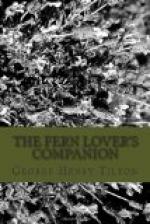Widely distributed, common and varying greatly in outline. The newer nomenclature separates the lady fern of our section into two distinct species, which should be carefully studied.[A]
[Footnote A: See monograph by F.K. Butters in Rhodora of September, 1917.]
(1) THE UPLAND LADY FERN. ATHYRIUM ANGUSTUM
Asplenium Filix-femina
The rootstock or rhizome of the Upland Lady Fern here pictured shows how the thick, fleshy bases of the old fronds conceal the rootstock itself. In the Lowland Lady Fern the rootstock is but slightly concealed by old stipe bases, and so may be distinguished from its sister fern.
One design of such rootstocks is to store up food (mostly starch), during the summer to nourish the young plants as they shoot forth the next spring. The undecayed bases of the old stipes are also packed with starch for the same purpose.
[Illustration: Rootstock of the Upland Lady Fern]
[Illustration: The same split lengthwise (From Waters’s “Ferns,” Henry Holt & Co.)]
[Illustration: Sori of Lady Fern. Athyrium angustum]
Rootstocks horizontal, quite concealed by the thick, fleshy bases of old fronds. Scales of the long, tufted stipes dark brown. Indusium curved, often horseshoe-shaped, usually toothed or fringed with fine hairs, but without glands. Fronds bipinnate, one to three feet high, widest near the middle.
This is the common species of northern New England and the Canadian Provinces. The fronds differ very widely in form and a great many varieties have been pointed out, but the fern student, having first learned to identify the species, will gradually master the few leading varieties as he meets them.
Those growing in warm, sunny places where the fruit-dots when mature incline to cover the whole back of the frond are called “sun forms.” These are varieties TYPICUM and ELATIUS, both with the pinnae obliquely ascending (including variety angustum of D.C. Eaton), but the latter has broader fronds with the pinnules of the sterile fronds oblong-lanceolate, somewhat acute and strongly toothed or pinnatifid.
[Illustration: Varieties of Lady Fern Left to right—1st and 2nd, Var. typicum; 3d, elatius; 4th, rubellum; 5th, uncertain, perhaps confertum]
Var. RUBELLUM has the sori distinct even when mature; its pinnules stand at a wide angle from the rachis of the pinna and are strongly toothed or pinnatifid with obtuse teeth. This variety favors regions with cool summers, or dense shade in warmer regions. The term RUBELLUM alludes to the reddish stems so often seen but this sign alone may not determine the variety. It occurs throughout the range of the species, being a common New England fern. Fernald remarks that this is also a common form of the species in southern Nova Scotia.
Among other varieties named by Butters are CONFERTUM, having the pinnules irregularly lobed and toothed; joined by a membranous wing, the lobes of the pinnules broad and overlapping, giving the fern a compact appearance; LACINIATUM with pinnules very irregular in size and shape, with many long, acute teeth, which project in various directions. “An abnormal form which looks as if it had been nibbled when young.”




